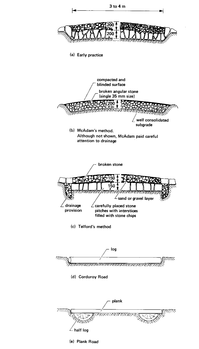


Chapter 6
I Construction During The Settlement Years
II The Use Of Timber As A Structural Material
III Structural Steel
IV Concrete Technology
V Housing
VI Industrialised Pre-cast Concrete Housing
VII Ports And Harbours
VIII Roads
IX Heavy Foundations
X Bridges
XI Sewerage
XII Water Engineering
XIII Railways
XIV Major Buildings
XV Airports
XVI Thermal Power Stations
XVII Materials Handling
XVIII Oil Industry
XIX The Snowy Mountains Scheme
XX The Sydney Opera House
XXI The Sydney Harbour Bridge
XXII Hamersley Iron
XXIII North West Shelf
Sources and References
Index
Search
Help
Contact us

Macquarie can be considered as the father of road planning in Australia. Soon after he arrived in Sydney, and concerned by the haphazard development, he was busy having streets widened, wrongly placed buildings removed, sign posts erected, houses numbered and traffic rules introduced. He was well known for his support for civil development and was popularly known as the 'builder'. He was also a dedicated traveller, who liked to supervise personally the laying out of new towns and the location of new roads. Macquarie set another precedent in 1812, when he turned to road-making to alleviate unemployment created by a depression in the economy.
By 1825 the search for abundant and fertile new land had expanded the settlement some 300 kilometres out from Sydney. Rugged country to the north of the Hawkesbury, however, remained as a major barrier. Newcastle was established by sea in 1801 and from 1804 till 1820 was used as a prison for convicts who had committed additional crimes in the Colony. The first track from Sydney to Newcastle was opened in 1823, following a route established in 1819. A proper road north, known as the Great North Road, was begun in 1826 and completed in 1836 under the supervision of Major Mitchell. It left Windsor for the Hunter Valley via Wiseman's Ferry. The road was largely constructed with a basecourse of 50 mm (or so) local sandstone spalls and a shale riding surface. This road, said to have been much the pride of Major Mitchell's heart, is still in reasonably good condition today, with parts undergoing historic preservation.
The route was subsequently moved east to near its current line, crossing the Hawkesbury at Peat's Crossing, which had opened as a ferry in 1844. By the 1850s the competition from steamship services between Sydney and Newcastle was so great that the land routes had fallen into disrepair and were rarely used. When a rail bridge was constructed over the Hawkesbury River in 1889, Peat's Crossing ferry was stopped, thus forcing road traffic back to the difficult Wiseman's Ferry route until the Peat's Crossing ferry was re-opened in 1930. A road bridge was not built until 1945. Although overland transport between Sydney and Brisbane began in 1840, a direct route was not completed until 1929.
It had been said by Karskens in As good as any in Englanthat the expansion of the Colony between 1810 and 1830 was a source of optimism and self-praise for the abundance of the new land, founded on the belief that the expansion would provide future wealth and happiness and that it demonstrated that intelligent man could civilise and improve the new land. Roads were one such civilising improvement and represented both prosperity and the conquering of distance. The original humble lines of road from Sydney grew into the Great Roads West, South and North, becoming symbols of Colonial optimism. These roads were largely constructed under Governor Darling, who saw them as amongst the most important achievements of his government. As noted above, they were usually located on lines established by Major Mitchell, who had a penchant for making such lines as short, straight and symmetrical as possible. Subsequent events in the history of Australia's road development will be found in Lay (1984).
The first engineering input into road making in Australia came with the introduction of McAdam's method of pavement construction into Australia in 1822, only seven years after he had begun to widely promulgate it in England. The first piece of macadam pavement was placed on the Prospect to Richmond Road west of Sydney. Nevertheless, the more expensive Telford method continued to be used in inappropriate circumstances in Australia for at least another half century (Fig. 22). This was due in part to the fact that road construction remained a publicly despised operation for recalcitrant convicts and that many of the army engineers who had been sent to Australia had had only a smattering of engineering training in road construction and usually even less experience. They would have missed the subtle but greater efficacy of the cheaper macadam. Indeed, Australia's first engineer in the real sense of the word was Royal Engineer Officer Barney, who arrived in 1835, but had little time to devote to road engineering.

People in Bright Sparcs - Barney, George; Karskens, Grace; Lay, M. G.; Mitchell, Major T. L.
 |
Australian Academy of Technological Sciences and Engineering |  |
© 1988 Print Edition pages 346 - 347, Online Edition 2000
Published by Australian Science and Technology Heritage Centre, using the Web Academic Resource Publisher
http://www.austehc.unimelb.edu.au/tia/348.html